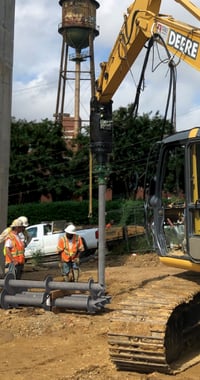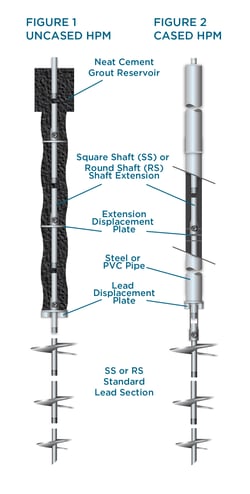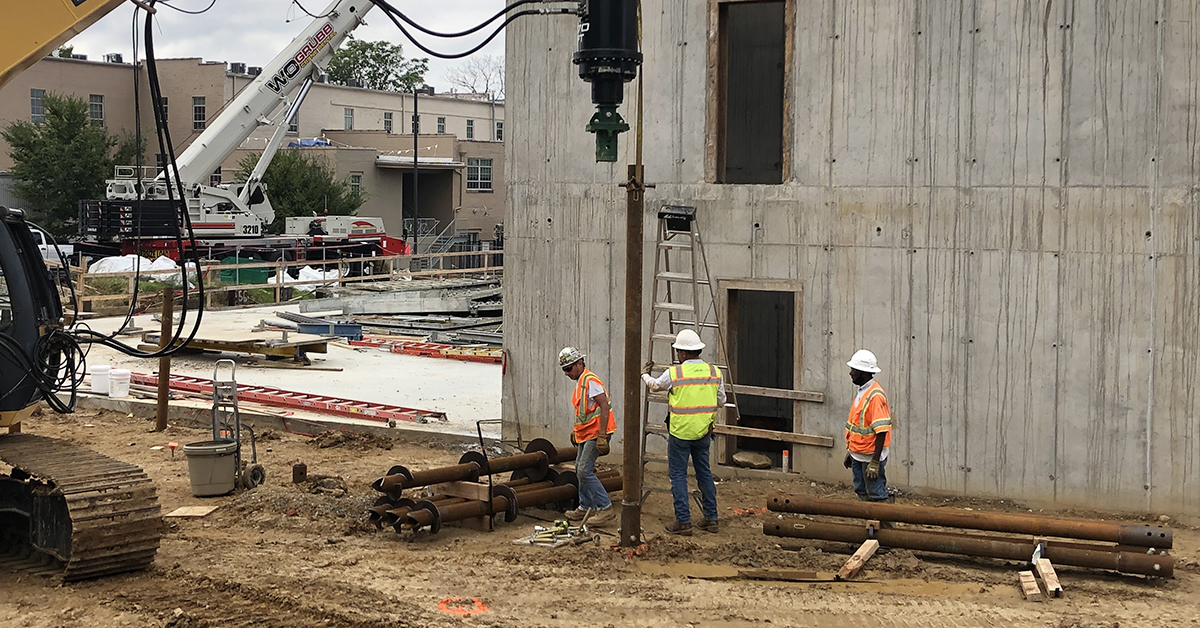 As the concepts and design of modern structures continue to evolve, so too must the deep foundation systems on which they are founded upon. With the help of modern technology and material science, structural boundaries continue to be pushed and economic considerations are causing a trend toward the increased use of high-capacity piles. In response to the demand, helical piles have expanded beyond light and medium loaded structures and have been engineered to support heavily loaded structures subjected to both compression and tension.
As the concepts and design of modern structures continue to evolve, so too must the deep foundation systems on which they are founded upon. With the help of modern technology and material science, structural boundaries continue to be pushed and economic considerations are causing a trend toward the increased use of high-capacity piles. In response to the demand, helical piles have expanded beyond light and medium loaded structures and have been engineered to support heavily loaded structures subjected to both compression and tension.
When it comes to deep foundations and high capacity piles in general, helical piles are often overlooked by today’s engineers. Perhaps it’s due to a lack of familiarity, or simply minimal evidence supporting their capabilities. Many designers are comfortable with more traditional foundation solution methods; however, helical piles provide a cost-effective alternative to traditional deep foundations such as drilled shafts. Beyond cost, helical piles offer many benefits not available with more traditional foundation systems. Learn about the benefits of Helical Piles vs Concrete Drilled Shafts (Caissons) in this article by CHANCE Senior Engineer, Shawn Downey.
In high-capacity applications, common concerns with helical piles tend to be uncertainty of load carrying capabilities, shaft buckling, and excessive settlement. On the contrary, load test data continues to indicate large load carrying capabilities for helical piles with low deflection values. With increased amounts of test data, as well as design improvements like the addition of grout columns for lateral support, larger diameter shafts, and increased wall thicknesses; helical piles in new construction applications are becoming increasingly viable. Here are several options when considering helical piles for high-capacity applications:
HIGH CAPACITY ROUND SHAFT HELICAL PILES
High-capacity round shaft helical piles provide an excellent solution for applications in soft soils requiring considerable lateral resistance or when buckling concerns exist. Extendable, they can be installed as deep as necessary to reach the required load bearing stratum in soil. The major distinguishing features and benefits include below are reflective of round shaft piles up to 7 inches in diameter. Greater capacities can also be achieved with larger diameter shafts.
- Capable of up to 90,000 foot-pounds of installation torque
- Up to 360,000 pound ultimate capacity and 180,000 pound working load.
- Excellent option for soft soils when buckling is a concern.
- Superior lateral load resistance
- Predictable Load Capacities
- Ideal for limited access areas
- Rapid Installation
- Minimal vibration and noise during installation
- No de-watering required
- Limited or no spoils
 HELICAL PULLDOWN® Micropile
HELICAL PULLDOWN® Micropile
The Helical Pulldown Micropile (HPM) is a method used to form a grout column around the shaft of a standard helical pile. The installation process can employ grout only (see Figure 1) or grout in combination with either steel or PVC casing (see Figure 2). By combining both end-bearing on the helical plates and skin friction along the rough surface of the grout column, the result is a higher capacity pile system. Load test data for a single 2-inch square shaft HPM has shown ultimate load capacities of up to 285 kips in compression.
Below is a case study where square shaft helical piles with a grout column were selected for a high capacity application.
Multi-story Condominium Case Study - Cambridge, Ontario
Dino Vito, M.A.Sc., P.Eng., Tayler Cook, University of Waterloo
EBS Geostructural Inc., Breslau, Ontario, Canada
A 13-story condominium tower was designed for construction in Cambridge, Ontario along the east bank of the Grand River. The site was the location of a former factory and was subject to a remedial clean up prior to construction. The soil on site was variable and had a very high water table due to its proximity to the river. Many solutions were considered for the deep foundations required including pipe piles, “H” piles, caissons, and helical piles.
 To determine the most efficient foundation design, testing had to be completed. The test results indicated a 2-inch solid steel, square shaft helical pile with an 8, 10, and 12-inch helical configuration was the most efficient pile design in the soil conditions, and the most cost-effective. Additional benefits of the helical piles included eliminating the need for soil removal and vibrations that might have caused issues with surrounding structures.
To determine the most efficient foundation design, testing had to be completed. The test results indicated a 2-inch solid steel, square shaft helical pile with an 8, 10, and 12-inch helical configuration was the most efficient pile design in the soil conditions, and the most cost-effective. Additional benefits of the helical piles included eliminating the need for soil removal and vibrations that might have caused issues with surrounding structures.
Based on the test data, design criteria included a minimum pile depth of 15 feet and a minimum of 6.5 ft into a suitable sand and gravel layer. All 730 helical piles were installed complete with a 6-inch diameter grout column in just forty working days and were able to resist an ultimate load of 285 kips in compression.
The ultimate load capacities of helical piles in compression and tension make them an increasingly effective foundation solution in many new construction applications. This is only one of many case studies on record, but one that clearly indicates that helical piles can be used in high-capacity applications.
Find out how to utilize helical piles to engineer a solution for a new construction project requiring lateral load capacity, or large compression and tension capacities. Click here to fill out a form to get the CHANCE Technical Design Manual and find your local distributor.

